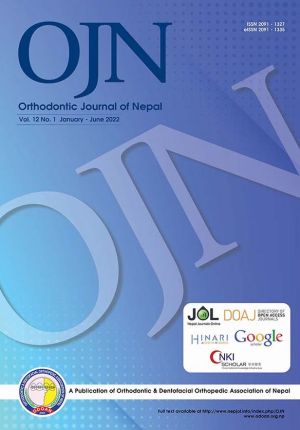Closing Loops; Geometry and Mechanical Properties: A Review
DOI:
https://doi.org/10.3126/ojn.v12i1.47493Keywords:
Closing loopsAbstract
Introduction: To verify the literature concerning the mechanical properties, measuring methods and the resultant force system developed by closing loops (CL). The effectiveness of a certain CL is related to its geometry and the nature of the wire material. To obtain the necessary performance CL must work in the elastic range and be geometrically configured to express an adequate force system, which is the result of compensatory gable bends and preactivation. It was performed a literature search in MEDLINE from 1974 to 2014 using search for “orthodontic AND retraction AND springs” and “orthodontic AND closing AND loops”. From the 147 papers resulted from Pubmed, 50 were chosen. Overall, many works seek not only improve the knowledge about the force system, but also a better understanding of their mechanical behavior. FEM, Holographic and Photoelastic studies, are tests commonly used before testing them experimentally. Wire material and the cross-section show a great influence in the choice of the geometric variables because the modulus of elasticity (E), modulus of resiliency (R) and the moment of inertia (I). Experimental tests should be preceded by numerical methods because the latter idealize a particular setting, and allows modifying variables.
Downloads
Downloads
Published
How to Cite
Issue
Section
License
Copyright (c) 2022 Orthodontic & Dentofacial Orthopedic Association of Nepal

This work is licensed under a Creative Commons Attribution 4.0 International License.
Copyright © held by Orthodontic & Dentofacial Orthopedic Association of Nepal
- Copyright on any research article is transferred in full to the Orthodontic & Dentofacial Orthopedic Association of Nepal upon publication in the journal. The copyright transfer includes the right to reproduce and distribute the article in any form of reproduction (printing, electronic media or any other form).
- Articles in the Orthodontic Journal of Nepal are Open Access articles published under the Creative Commons CC BY License (https://creativecommons.org/licenses/by/4.0/)
- This license permits use, distribution and reproduction in any medium, provided the original work is properly cited.




